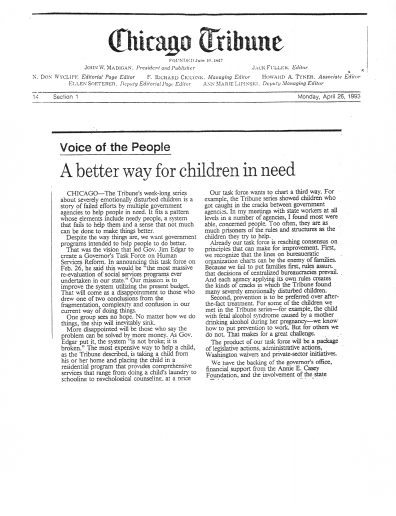Chicago Tribune
04/26/1993
Copyright Chicago Tribune 1993
by Gary MacDougal
 The Tribune's week-long series about severely emotionally disturbed children is a story of failed efforts by multiple government agencies to help people in need. It fits a pattern whose elements include needy people, a system that fails to help them and a sense that not much can be done to make things better .
The Tribune's week-long series about severely emotionally disturbed children is a story of failed efforts by multiple government agencies to help people in need. It fits a pattern whose elements include needy people, a system that fails to help them and a sense that not much can be done to make things better .
Despite the way things are, we want government programs intended to help people to do better .
That was the vision that led Gov. Jim Edgar to create a Governor's Task Force on Human Services Reform. In announcing this task force on Feb. 26, he said this would be "the most massive re-evaluation of social services programs ever undertaken in our state." Our mission is to improve the system utilizing the present budget. That will come as a disappointment to those who drew one of two conclusions from the fragmentation, complexity and confusion in our current way of doing things.
One group sees no hope. No matter how we do things, the ship will inevitably sink.
More disappointed will be those who say the problem can be solved by more money. As Gov. Edgar put it, the system "is not broke; it is broken." The most expensive way to help a child, as the Tribune described, is taking a child from his or her home and placing the child in a residential program that provides comprehensive services that range from doing a child's laundry to schooling to psychological counseling, at a price tag of $47,000 per year. That is a lot of money to try to help one child.
The choice seems to be helping children where they live and risking the lousy results documented in the Tribune series or moving children to a place where one organization is responsible for helping the child and hoping the child does better there than at the hands of a fragmented system.
Our task force wants to chart a third way . For example, the Tribune series showed children who got caught in the cracks between government agencies. In my meetings with state workers at all levels in a number of agencies, I found most were able, concerned people. Too often, they are as much prisoners of the rules and structures as the children they try to help.
Already our task force is reaching consensus on principles that can make for improvement. First, we recognize that the lines on bureaucratic organization charts can be the enemy of families. Because we fail to put families first, rules assure that decisions of centralized bureaucracies prevail. And each agency applying its own rules creates the kinds of cracks in which the Tribune found many severely emotionally disturbed children .
Second, prevention is to be preferred over after-the-fact treatment. For some of the children we met in the Tribune series-for example, the child with fetal alcohol syndrome caused by a mother drinking alcohol during her pregnancy-we know how to put prevention to work. But for others we do not. That makes for a great challenge.
The product of our task force will be a package of legislative actions, administrative actions, Washington waivers and private-sector initiatives.
We have the backing of the governor's office, financial support from the Annie E. Casey Foundation, and the involvement of the state officials whose agencies are responsible for the well-being of children and families most in need. While there may always be children of great need, there need not be a system of human services whose cracks and crevices result in a substantial portion of those children being left behind.